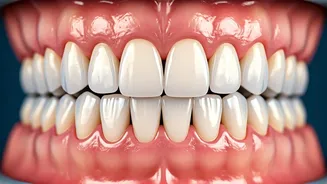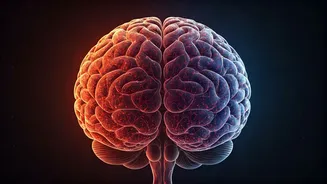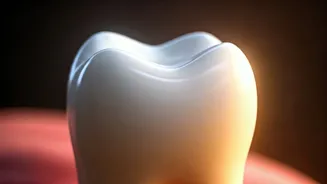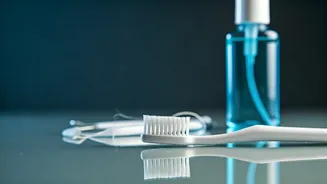Visible Crowding & Gaps
One of the most apparent signs of misaligned teeth is when they appear crowded or have noticeable gaps. Crowding happens when there isn't enough space
in the jaw for all the teeth, causing them to overlap or twist. Gaps, on the other hand, occur when there's too much space, creating unsightly spaces between teeth. These gaps can be caused by missing teeth, small teeth, or the natural movement of teeth over time. Both crowding and gaps can affect your bite, making it difficult to chew food properly, and increasing the risk of dental problems like cavities and gum disease. Recognizing these visible irregularities is the first step in seeking professional advice and potentially undergoing orthodontic treatment to improve your oral health and smile aesthetics.
Chewing or Biting Issues
Difficulty chewing or biting food can also signal misaligned teeth. When teeth don't meet correctly, the force of the bite isn't distributed evenly. This uneven pressure can lead to chewing difficulties, making it harder to break down food efficiently. It might lead to muscle strain in the jaw and temporomandibular joint (TMJ). Individuals with misaligned teeth often find that certain foods are difficult to eat, and they may experience discomfort or pain while chewing. These issues highlight the impact of dental misalignment on overall oral function. Addressing the misalignment can enhance chewing efficiency and alleviate related discomfort, contributing to better oral health and general well-being.
Frequent Cheek Biting
Biting the inside of your cheeks frequently might indicate misaligned teeth. When teeth are improperly positioned, they can rub against the soft tissues of your cheeks, leading to accidental bites and irritation. This is especially common when the upper and lower teeth don't align correctly. Such repetitive biting can cause sores and discomfort, as well as potential for infection. This is due to the exposed tissues. It is very important to recognize this as a sign. It often signals that the bite needs to be corrected. By getting dental care, people can reduce the chances of cheek biting. They can also reduce the pain and irritation that it may cause.
Jaw Pain and Clicking
Experiencing jaw pain, clicking, or popping sounds when you open or close your mouth can be linked to misaligned teeth. This can impact the temporomandibular joint (TMJ), which is responsible for jaw movement. Misaligned teeth can put extra strain on the TMJ, leading to discomfort, headaches, and even TMJ disorders. The clicking or popping sounds happen when the joint doesn't move smoothly. It's important to consult a dentist if you have any of these symptoms. They can check the teeth and jaw, providing a correct diagnosis and suggesting therapies. Straightening misaligned teeth can relieve this stress on the TMJ. This helps to reduce pain and improve jaw function, leading to enhanced oral comfort and health.
Speech Difficulties & Lisp
Misalignment of teeth can occasionally influence speech patterns, causing certain sounds to be difficult to pronounce correctly. This may result in a lisp or other speech impediments. When teeth aren't properly aligned, they affect how air flows through the mouth, which is essential for producing clear sounds. For instance, misaligned front teeth can obstruct the formation of 's' or 'th' sounds. If you find yourself struggling with certain sounds or notice a change in your speech, misaligned teeth could be a factor. Correcting the alignment might enhance speech clarity. Consult a dentist to evaluate your dental condition if speech difficulties persist, and consider solutions like orthodontic treatments.
Uneven Tooth Wear
Tooth wear that appears uneven is another indication of misaligned teeth. Teeth that don't meet properly are at a higher risk of premature wear and tear. The uneven distribution of forces during chewing causes some teeth to bear more pressure than others, leading to faster wear on the enamel. This wear can manifest as flattened, chipped, or cracked teeth over time, which not only affects your smile but also exposes the teeth to a greater risk of sensitivity and decay. If you notice that some teeth are wearing down faster than others or if their edges are irregular, it is crucial to consult a dentist. Addressing the misalignment can reduce uneven wear and protect the longevity and health of your teeth.









